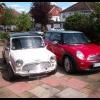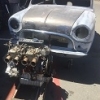A friend of mine is a London RT and Routemaster Bus enthusiast and he used to drive them.......it made me smile when I went with him to a bus show at Brooklands recently as he described the difficulties of identifiying the 'genuine' works history and provenance of these old buses due to all the body, chassis and numberplate swaps that took place during their major overhauls at the Aldenham Bus Works between 1956-1986......the bodies where seperated from the chassis when they arrived and at the end of the refurbishments the same body and chassis/engine did not necessarily get reunited with each other or the original reg number! So we think we have problems with the works Minis! ![]()
![]()
This great 1957 film explains the overhaul process. ![]()
'A guided tour of the once famous Aldenham bus overhaul works of London Transport in 1957.'
The 'Aldenham Works' Wikipedia link also has these interesting quotes:-
"It was highly unlikely that a chassis would leave the works with the same body, engine or gearbox that it entered with. Indeed, it was even possible for a bus to enter the works in the morning, and a bus carrying the same fleet number and registration number to leave later the same day - although a completely different vehicle." ![]()
"One of the unusual aspects of the Aldenham overhaul concept was the "Works Float" system. As chassis generally took less time to overhaul than did the bodies, this would have resulted in chassis cluttering up the works awaiting completed bodies. This required the number of bodies in the overhaul system to be greater than the number of chassis in the works. To provide this, a number of vehicle identifications became part of the works float and disappeared off the road, sometimes for years. Effectively, these buses ceased to exist except on paper, to provide the necessary spare components to allow the works float system to operate. This system permitted the number of road licences held to be less than the number of buses in existence, the unlicensed vehicles effectively being the vehicles under overhaul - a considerable financial saving. A system of separate chassis and body numbers was utilised to keep track of these major components. The works float system ceased in the mid-1980s when the practice of body separation was abandoned."
















